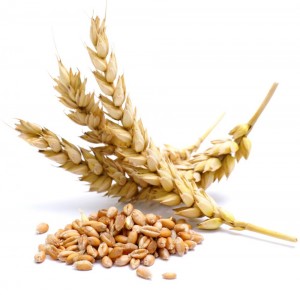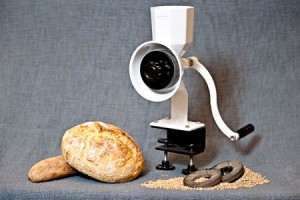I’m pretty stoked that my wife and I just bought a hand operated wheat grinder; it’s a workout, but I works like a charm. In our basement with our food storage we had to 40 LB bags of wheat so while they were fine and are making great flour; it made me curious about average shelf life of both flour and raw wheat. The bag we have is made for food storage and is “tripled cleaned” and double bagged. I hope you will find this information useful.
This article has quite a few references and excerpts from articles and I’ve tried to keep the websites mentioned throughout so you can check out the sources. If you are curious, we purchased a Wonder Mill Junior after looking at several models of hand operated grinders; it’s a solid little bugger and I think it’ll treat us well.
I was reading some Q&As from thesurvivalistblog.net and came across this little bit of info that pretty much sums up everything else I have and am coming across:
“Some of my wheat I vacuum sealed in bags and some I vacuumed into preserving jars using a Food Saver. I placed the bags and jars into food grade buckets (not vacuum sealed) to protect them and stored them in the basement of our home which keeps an average temperature of 10-12 deg. C year round. I live in NZ.”
Sue
“If kept free of outside moister and vermin wheat in whole grain form will store for 30 years or more. Wheat seed was found in the pyramids that was dated to around 2500 BC or 4,500 years old – scientists planted some of the seed and it sprouted and grew.”
-M.D. Creekmore
The website goes on to provide a good food storage shelf-life chart that I found quite useful and wanted to share. I cut out the hyperlink and just share the pdf from foodstoragemadeeasy.net.
Once it is ground flour is an entirely different beast. Flour shelf life is 6-8 months past expirations date of stored properly. And that is the flour from the store with additives, chemical enhancements, and preservatives. From goodlifeeats.com “Grind only what you can use. Once a grain has been ground into flour it begins to lose its nutritional value very quickly. If you do grind a little extra, store it in a tightly sealed container in the freezer and use within a few days’ time.”
From eatbydate.com: Proper food storage is the key to extending the expiration date of food. If purchased, the best way to store flour is in its original container in the pantry, but also inside of a plastic bag or airtight container. All varieties last for a longer period of time if they are stored in a cool, dry environment. It should also be kept in a vapor proof container because the powder easily absorbs nearby odors and chemicals from anything around. When the bag is opened, it can be poured into another air tight container. Or, the original bag can be placed inside of a plastic bag for extra protection.
The shelf life of whole grain flour can be extended by several months by storing it in the fridge or freezer, but this is not recommended for white flour as the expiration depends upon it remaining completely dry.
Eatbydate.com draws their research from multiple resources, including the United States Department of Agriculture and the United States Food & Drug Administration. Although the flour shelf life information on Eat By Date is generally reliable, please remember that environments vary and thus individual cases will vary so our advice should only be taken as an opinion and guide to the shelf life of foods. So, please eat responsibly!



Leave a Reply